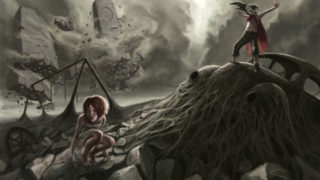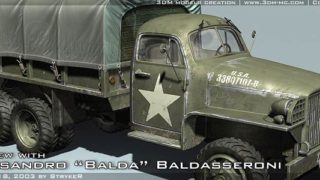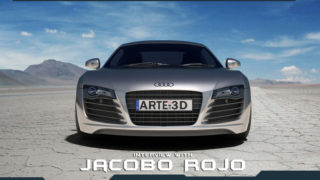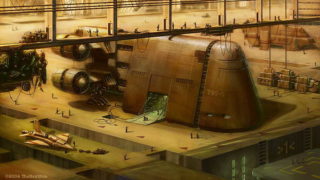
Interview with Warwick Mellow
Interview with great artist Warwick Mellow, which has created amazing animation – PAN – dancin’ Greek God.
Interview with Warwick Mellow
August 12, 2003 | Stryker
 |
Hello Warwick, can you please introduce yourself?
Hi, I’m a 22 year old 3D enthusiast who has just finished studying and tutoring at University. I’m currently looking to make the transition from studying to a full time career in 3D animation. PAN was created as the main piece for my showreel.
What software do you currently use?
PAN was created using MAYA 4.5, Photoshop 6, Adobe After Effects and Premier.
What’s the primary hardware you work on? Is it a hobby system or a business system?
I work on a hobby system – AMD Athlon 2000+ with a GeForce3 Ti200 Videocard (64 MB). I got a friend to help me patch the drivers for my GeForce so it runs a little like a Quadro 4. I’ve been extremely happy with this system.
If you had a chance to own any of the current 3D programs, overall which one would be your choice and why?
 |
MAYA – I think it’s a fantastic program. Easy to use, fully customisable menu system, great animation controls and editing menus, fur, cloth and particle dynamics built in – it’s like 10 programs in one. What more could you want? I also love how it gives you complete control over all the processes in 3D, right down to the finest details. I’m a sucker for attention to detail.
Aside from the software debate, I truly believe a program can’t make you a brilliant artist. The computer is just a tool, like the pencil and paper or paint and canvas.
What type of Art Education did you acquire in the past?
I have a Uni degree in Creative Industries (Communication Design). It wasn’t solely an animation degree but also featured website design, CD-ROM programming and digital video. I majored in 3D animation and decided to do an extra year (Honours) to develop my skills and concentrate on an area that I was interested in researching – the importance of anatomy and kinesiology in 3D character animation.
Do you feel that an artist looking forward to jumping into a career in Art requires Art Education?
I’m a strong advocate of education. If you’re a talented artist, education provides a structure to help develop your own unique abilities. Being in a creative environment also allows you to bounce your ideas off others, be inspired and learn from your peers.
Many courses these days offer excelled classes in 3D techniques and don’t place a strong enough emphasis on traditional animation theory. Film theory, storytelling, life drawing and acting are also fundamental. Learning a process, not a program, is what to look for in a good animation school.
 |
| 1. Stoa of Attralus fronting the Agora, Athens. 2. Coister of S. Maria della Pace, Rome, 1500-04, Donato Bramante. |
When and how did you get the idea for this character? Or was this character a result of something you came upon?
 |
| Front and side profiles of Pan – original artwork and final modeling templates. |
I needed to find a muscular character that would apply to the research and application of kinesiology in 3D arts practice.
The idea of animating a Roman or Greek statue seemed promising because of the detailed anatomy involved. Also the concept of a statue coming alive seemed interesting and creative compared with animating a regular, real life human being with the inherent difficulties in making it fully realistic in all aspects.
When looking through a book of Greek statues I came across the pagan God ‘Pan’. He was a perfect subject incorporating both human and animal characteristics.
The combination of a goat’s hind legs, beard and horns with a man’s upper torso made Pan ideal for the application of kinesiology to 3D arts practice. Not only could the anatomy and kinesiology of humans be applied but also the anatomy and kinesiology of goats. Because Pan is a magical, mythical creature, his design and movement was open to interpretation and artistic license. An audience doesn’t know how a man with goat legs is supposed to walk so appropriate use of anatomy and kinesiology could be used to readily create realistic and convincing motion. Also, statues are made of stone so hair and complex facial movements could be excluded to simplify the animation.
Have you done any sketches for the design of the character?
Yes, I always start my work on paper. I designed Pan using references from Greek statues and paintings and illustrations of satyrs (goat men of mythical Greece). Pan’s appearance is already well defined in mythology but I was determined to make a design of my own. It’s important to personalise a character for animation – it helps you to get inside their head. Probably my strongest reference was Bouguereau’s "Nymphs and Satyr (1873)" – a magical painting of four nymphs capturing a satyr.
 |
| The final design implemented in 3D. |
When did the development of the character start?
After I decided what my research topic was going to be. Because the project was research in nature, I did a whole heap of character setup tests and documentation before I modelled and implemented them in Pan’s final setup. I also spent a great deal of time researching Pan before I started any 3D work – he was such an intriguing character.
 |
What program was Pan modelled in? And in What way?
I used MAYA and modelled solely in polygons. I used an edgeloop method of modelling so that all surface contours naturally flow into each other, the way they do in the human body. This ensures the skin deforms in the direction the muscles naturally flow.
Did you use motion capture?
No. I’ve been asked this question a bit which is really flattering because I animated with the pose to pose method using imported video reference of John Travolta (Saturday Night Fever) and Michael Jackson (1995 MTV Music Video Awards). In traditional animation terms it’s called rotoscoping.
I really believe that the illusion of realism in the performance comes from the character setup. I’m no genius in animation that’s for sure. Having biceps bulge or ribs compress when a movement is performed really adds to the realism of animation, however subtle it is.
Why these songs? Where did the idea come from?
Mythologically, Pan was quite a character. His character traits were diverse ranging from being a skilled musician and dancer to a frightening sexual creature that ran through forests chasing nymphs. He is most renown for his promiscuity and free spirit.
I thought it would be funny having Pan dance like John Travolta and Michael Jackson because of the inherent sexual connotations in their performances – hence the choice of music.
 |
| 1. Iconic Order, from the Temple of the Illissus, Athens, 449 BC. 2. Doric, Iconic, Corinthian pillars. |
Do you have any future shorts you plan on releasing and would like to mention or promote?
I’ve always got ideas floating inside my head. I’ve got a concept for an animation inspired by the Metallica song, "Call of Ktulu" which I’m quite excited about and really want to develop into a short. I’m also keen to do a wolfman (fur and all) – I’m always disappointed in the werewolves you see in movies – it’s always a man with a dog’s head or a hairy man. I wanna do a wolfman that stands upright, but is half wolf and half man – using appropriations in anatomy to get the setup right.
How many bones were used in the Character Animation setup?
Not sure and I really don’t want to have to count them! Most notably though is the 4 bone/shoulder setup which incorporates a clavicle and scapula before attaching to the humerous (upper arm). I used a fair few for the spine to get good procedural motion as well as four in each forearm for the same reason. Reverse foot setup, ribs – there’s a fair few.
How long did the animation take to render?
Between 4-12 minutes per frame.
 |
Do you have any good books to recommend?
I’m glad you asked this question.
For anatomy – human and animal
Szunyoghy, A. & Feher, G. (1996) Anatomy Drawing School, Koln: Konemann Verlagsgesellschaft.
A technical book which explains the workings and movement of bones – brilliant illustrations.
Modelling reference
Hogarth, B. (1970) Dynamic Figure Drawing: A New Approach to Drawing the Moving Figure in Deep Space and Foreshortening, New York: Watson-Guptill Publications.
Hogarth’s book shows the muscle with real form and depth so it’s easy to conceptualise from all angles when modeling.
Disney
Thomas, F. and Johnston, O. (1984) Disney Animation: The Illusion of Life, California: Walt Disney Productions.
Every animator must own this book!!!
Plus the Learning MAYA books from aliaswavefront are by far, the best introductory books anyone could ever own for learning MAYA.
Thank You very much for your time Warwick!








